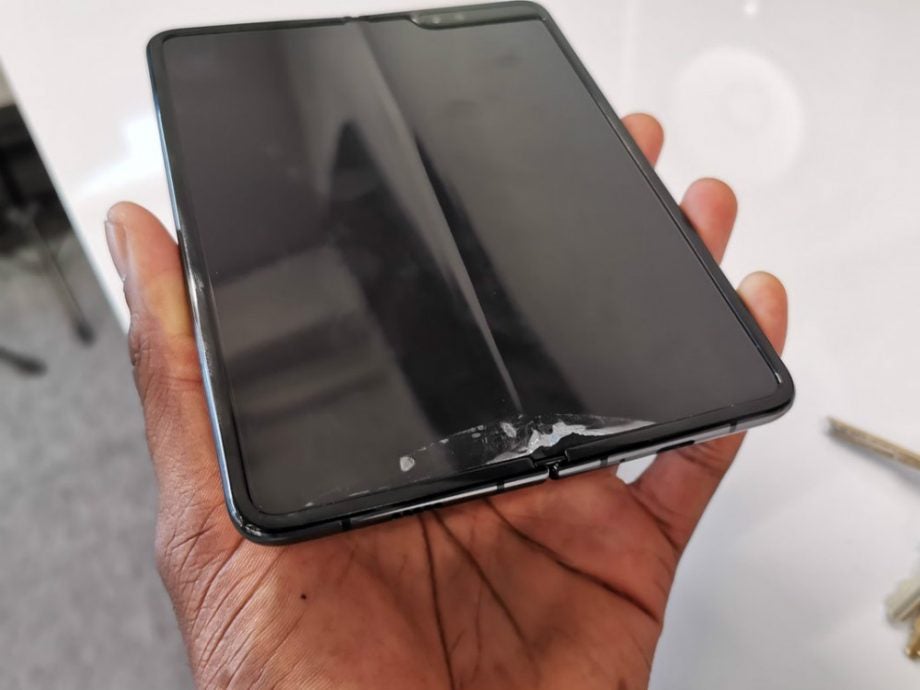The Galaxy Fold’s problems go deeper than the not-a-screen-protector

As you’ve no doubt already heard, several tech journalists and well-known industry personalities are reporting that their Samsung Galaxy Fold review units have already broken, after less than two days of use. Worse still, the issue isn’t clear cut.
“A limited number of early Galaxy Fold samples were provided to media for review. We have received a few reports regarding the main display on the samples provided. We will thoroughly inspect these units in person to determine the cause of the matter,” reads Samsung’s official statement.
“Separately, a few reviewers reported having removed the top layer of the display causing damage to the screen. The main display on the Galaxy Fold features a top protective layer, which is part of the display structure designed to protect the screen from unintended scratches.
“Removing the protective layer or adding adhesives to the main display may cause damage. We will ensure this information is clearly delivered to our customers.”
YouTuber Marques Brownlee and Bloomberg’s Mark Gurman say they did remove the protective layer. Why? Because it looks like a regular screen protector − the kind you’ll find on all new phones and tablets.
How are people not going to peel this off? https://t.co/uSkhSLYewH
— Mark Gurman (@markgurman) April 18, 2019
Trusted Reviews’ mobiles editor Max Parker, who went hands-on with the Galaxy Fold at an event on Monday, says he was told not to remove the protective layer by reps.
“The outer-layer of the display is quite noticeable (especially around the edges) and I did first think it was a pre-attached screen protector Samsung had somehow forgot to mention,” Max told me.
“I was quickly told by reps on hand at the Samsung briefing that it was actually part of the display itself. Unless this is communicated super-clearly to consumers I can imagine lots of people peeling this layer off thinking it was just a cheap protector that didn’t have to be there”
Unfortunately, it appears that not all journalists were warned.
There was no explicit communication that I recall at the briefing to pick up the device around not removing the film. There was an email about a day later. Naturally, one would unbox and start using a NON-embargoed device immediately, not wait a day for follow up instructions.
— Mark Gurman (@markgurman) April 18, 2019
Consumer units, it appears, will ship with an instruction reading: “The main screen includes a special protective layer. Peeling off the protective layer or using any adhesives on the main screen, such as screen protectors or stickers , may cause damage.”
Review units, unfortunately, did not ship with that warning.
Has anyone else found this text anywhere in the box? Mine didn't have anything printed on the plastic wrapper.
— Marques Brownlee (@MKBHD) April 17, 2019
However, the plot thickens further. The Verge’s Dieter Bohn and CNBC’s Steve Kovach and Todd Haselton say their Galaxy Fold review samples broke despite the fact they didn’t remove the protective layer.
After one day of use… pic.twitter.com/VjDlJI45C9
— Steve Kovach (@stevekovach) April 17, 2019
For the curious: this is the plastic wrap that covered the Galaxy Fold review unit, without any warning on it. This is not the protective film which was removed on some units due to lack of warning. (We never removed protective film and it still broke.) pic.twitter.com/HWNqxCo6s7
— Todd Haselton (@robotodd) April 18, 2019
“CNBC didn’t remove that layer, and our screen is now also failing to work properly. When opened, the left side of the flexible display, which makes up a large 7.3-inch screen, flickers consistently,” CNBC explains.
Bohn says he could see and feel a “small bulge” directly on the crease of his review unit before it started malfunctioning.
“It’s just enough to slightly distort the screen, and I can feel it under my finger. There’s something pressing up against the screen at the hinge, right there in the crease. My best guess is that it’s a piece of debris, something harder than lint for sure. It’s possible that it’s something else, though, like the hinge itself on a defective unit pressing up on the screen.”
My review unit had that weird bump under the screen at the hinge. Whatever it was eventually broke the screen. The whole experience was unsettling. I was unsettled. I guess I felt
…
The rattle of the bulge
— Dieter Bohn (@backlon) April 18, 2019
All of which indicates that there’s more than one thing wrong with the Galaxy Fold. According to The Wall Street Journal’s Joanna Stern, Samsung’s PR team has said the company has no plans to push back the handset’s release.
Also from Samsung PR: “There are no changes to the plans – we are launching in the U.S. on April 26.”
— Joanna Stern (@JoannaStern) April 18, 2019
April 26 is when pre-orders go live in the UK. We’d recommend waiting for this story to play out before even considering shelling out £1799 for one.
Were you considering buying a Galaxy Fold? Have you changed your mind? Let us know on Twitter @TrustedReviews.


